

 |
 |
'Now slides the silent meteor on, and leaves
A shining furrow, as thy thoughts in me'
Lord Alfred Tennyson The Princess (VII)
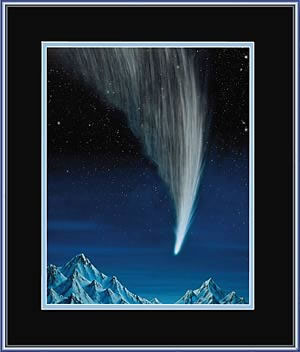 |
Try this experiment. The next time you are walking through your local town stop the next person you meet (I do not expect you to actually do this) and ask them to name a comet. I would wage a bet that the vast majority of people would say 'Halley's Comet'. This bright and periodic visitor which bares Halley's name and graces Earths skies every 76 years has been recorded by many cultures during each of its historic apparitions.
Halley's predictions were important for they proved that comets obey Newton's laws of gravity, can return, and even be forecast by using orbital calculations. Every time this comet appears in our skies SOMETHING of significance is happening among the men of Earth. It appeared during the battle of Hastings in 1066 and in 1910 it was a spectacular sight (many people who claimed to have seen it actually confused it with the brighter 'Great January comet' that was visible in daylight) which caused fear by all who saw it. During this time Cyanogen, a poisonous gas, was discovered within the comet and during one 'fateful' night the Earth was due to pass through the comets tail which resulted in mass panic. Blocking chimneys and gaps under doors was a common sight as many believed they would meet their doom before dawn. It didn't happen, however Halley left its mark on the minds of men yet again!
I wish I could say that I had seen 1P/Halley. It last appeared in 1986 as a naked eye object but it was low in the sky for observers at mid northern latitudes. I was eight years old at the time and new nothing about astronomy but I do recall the television and newspapers creating excitement about the comet. I recall joining a group of neighbours and together we stood out in their back garden on one dark night hoping to see the comet. We new nothing about comets and we expected to see something like a ball of flames shooting across the sky but of course we were wrong and not one of us seen it.
However all is not lost. Despite the fear and superstition which surrounds the comet, Halley is actually very kind to us, and if you know where to look you can see 'bits' of this famous comet twice EVERY year. At the heart of Halley's comet is a potato shaped nucleus measuring 8 km (5 miles) wide and 15 km (9 miles) in diameter (about the size of the object which caused the K-T extinction event). This rotating, spitting, icy mountain releases huge quantities of dust blown beyond the the pull of the comets feeble gravity by active jets and fans.
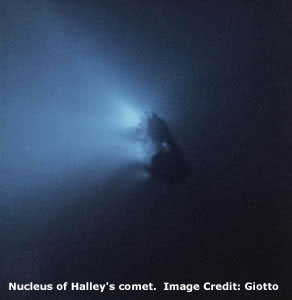 |
These exotic dust particles form the coma (head or atmosphere around the nucleus) and tail of the comet. As the comet moves into the inner solar system and around the Sun in its highly elliptical orbit, these dust particles trail behind and form their own orbit around the Sun. These particles form part of the Gegenschein and Zodiacal dust complex we can see from Earth. Perhaps they even play a role in the formation of Noctilucent clouds which can be seen during Summer months. However most spectacularly they produce a meteor shower!
Twice every year the Earth ploughs through the tail debris of Halley's comet. First during May producing the Eta - Aquarid meteor shower and again during October causing the delightful Orionid Meteor shower. This year the shower peaks during the day on Saturday Oct 21st so the nights before and after the peak would be a fruitful time to watch for meteors. Conditions are favourable this year as the sky will be completely dark with the Moon just one day from new during maximum.
Halley's comet is the only short period comet which moves in a retrograde orbit. This is plain to see when they enter the atmosphere at a rapid speed of 66km/sec often leaving persistent glowing ion trains. Fireballs are common three days after maximum. The expected ZHR (Zenith Hourly Rate) is estimated at 25 meteors per hour under excellent conditions although this rate rarely happens as the ZHR requires the radiant (the Orionids have at least four moving radiant's located NE of Betelguese in Orion) to be at the zenith under dark skies with stars to mag +6.0 visible to the naked eye for a single observer. In 1910 the Earth's encounter with Halley's tail was a time of fear but in modern times its a time filled with suspense and excitement, and most important of all - joy. I looked forward to our encounter with this great comet. The following documents several nights of observing.
01.40 - 03.20 / 04.15 - 06.05 BST
The forecast looked very poor for the Orionids this year. Tonight was calm, wet, quiet, T= 6-7 with clouds and patchy fog. It was very cool. My sister and I went for late night walk in the country and suddenly the sky cleared. The green Gegenschein and Zodiacal band were easy to see and beautiful beyond words. I immediately began to see Orionid meteors and very soon it became evident that the activity was very good, in fact it was great so I began a photographic meteor patrol at ISO 800/15 sec exposure at F/3.2. Many meteors seemed to shoot through Orion itself and the area of sky within 40 degrees of the radiant seemed to be fruitful so I began my patrol in these regions. Much to my surprise 5 meteors shot through my patrol field however they were too faint for my camera to record but the visual show was impressive. During this watch I seen 30 meteors, many of which were high quality objects, brighter than mag +3.0, white in colour, and leaving glowing green ion trains in their wake. My sister and I seen a lovely mag - 3.0 Orionid light up the clouds as it burnt up low in the NW sky above the hedgerows which covered the countryside.
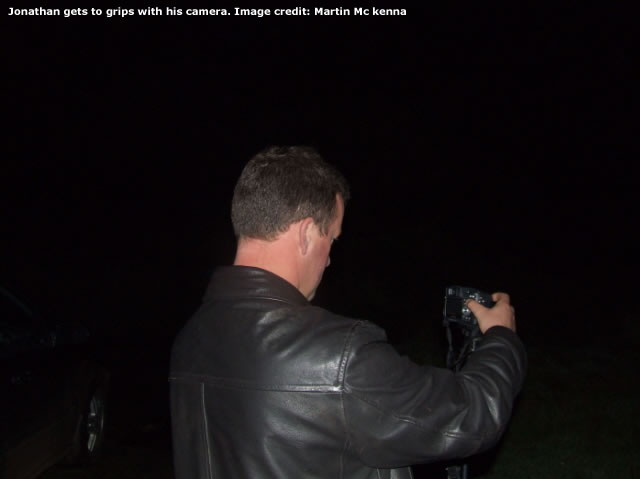 |
We walked home then I began my second session which lasted until just before dawn. I continued my meteor patrol while periodically cleaning the lens of my camera as a heavy dew had descended and had to be monitored incase it formed a grey film over the lens which would block out any meteors from being recorded on the CCD chip.
On two occasions I was greeted by a V-shaped formation of Geese passing very low over my head. First from N to S then another formation flying W to E. The mild orange glow from the lights of Maghera illuminated their bellies and wings. The night was so quiet that I could hear the beat of their large wings and their calls rise in volume then fall as they vanished toward the dark horizon - wonderful encounter.
Meanwhile the Orionids continued to put on a great show and by the time I retired for the night at 06.05 I had logged 58 meteors, 4 of which were non shower members, and the rest Orionids! I was excited by this count and was eager to see what I could get tomorrow night.
20.30 - 03.00 BST
The weather forecast again looked poor for tonight and on Saturday but we did not want to give up so we decided to carry out an Orionid watch no matter what the weather was doing. My local astronomical society was holding a watch from Killylane outside Larne, however due to the forecast we decided to change or plans and complete a watch from Maghera instead. We contacted our friend Jonathan Bingham who decided to join us tonight. Jonathan arrived after 20.30 and the sky was cloudy. Conor Mc Donald, Jonathan, and myself spent some time on the computer studying the latest cloud charts and things were not looking good. We checked the online aurora charts also. Tonight a solar wind stream from a coronal hole in the Sun was due to impact increasing the possibilities of seeing an aurora. The charts were slightly active indeed however aurora sightings seemed to be confined to high latitudes.
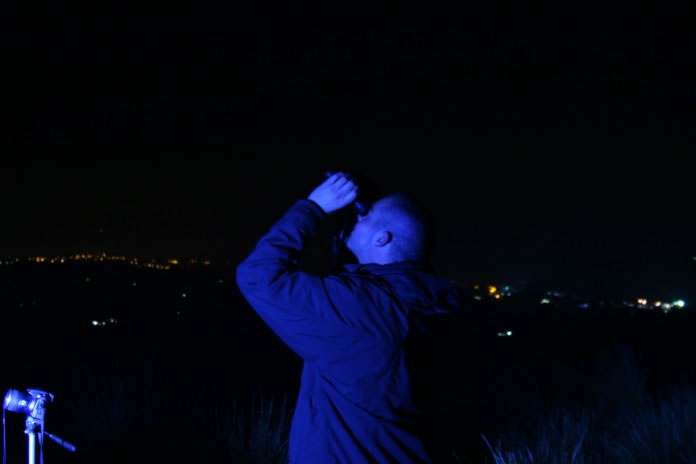 |
We then drove to the top of Ranahan Mountain outside Maghera. The view was great, the distant lights of Maghera and Magherafelt were rather soothing to watch and the silence was periodically interrupted by a few fireworks lighting the clouds on the horizon. Mist/fog and light clouds were a serious problem but it did not dampen our spirit. We glimpsed a few stars with the naked eye in Cygnus, Andromeda, Taurus, Pegasus, Aries and Polaris and using Jonathan's 16x40mm binos we glimpsed M31 and M45 through light clouds which quickly thickened again for the rest of the night. No meteors observed. We all had a great chat about astronomy and photography complimented by improving our imaging skills by taking night time exposures of distant down lights and trees so the time was very productive. This process was helped by many mugs of tea, a few viscounts biscuits, and an extra large bar of Toberlone! The session ended at around 01.00 BST. Conor and I stayed out until 03.00 hoping for clear breaks but rain arrived on the scene. We were approached by two young drunks who were very curious about the two strange dark figures holding tripods and cameras at 02.30 on a cloudy night however the encounter was benign and the conversation evolved into a chat about the Orionids and Halley's comet so perhaps they learned something new!
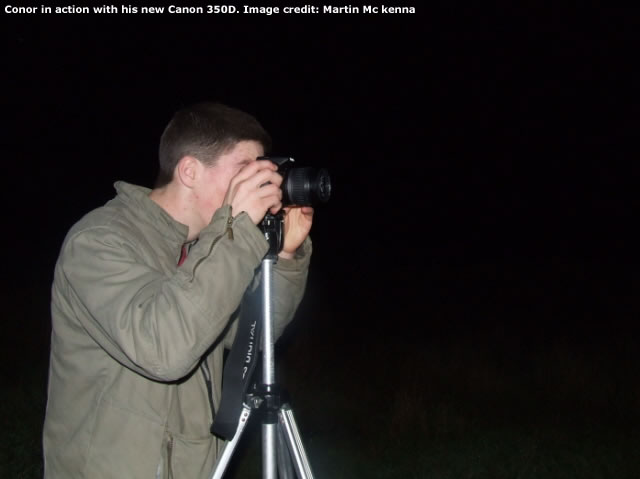 |
23.50 - 03.10 BST
The night began clear and I had already set up the 8.5" dobsonian reflector in the backyard to cool down. I spent one hour searching for new comets then turned my attention to bright comet SWAN at the time located in the western evening sky within Bootes. The comet was a beautiful sight in the 40mm eyepiece with a green mag +6.0 moderately condensed coma and green ion tail extending for at least 1.5 degrees long. I watched the comet pass over a bright field star causing the stars light to dim which was a wonderful experience. See my sketch.
Conor Mc Donald and I then met up for another Orionid watch, this time from a field in the country not far from home. The sky was 90% cloudy with high quality short duration gaps. We began yet another photographic meteor patrol. Conor using his new Canon 350D, and me with my Fujifilm S5600. We seen several meteors and one borderline fireball in the south. Overcast conditions developed and we ended the watch at 01.30. Later the clouds broke and I done yet another patrol until 03.10 when I seen two more borderline fireballs through light clouds. Total meteors seen = 10.
01.40 - 03.00 BST
Very cold, calm, quiet, dark sky, T= 7-8 with patchy mist and fog in places. Sky was in good shape tonight. The Gegenschein and Zodiacal band were easy targets and a true testament to the quality of the night. Tonight I seen 47 meteors, of which 43 where Orionids and 4 where a combination of sporadics and Taurids. The highlight was a borderline fireball in Gemini and a beautiful orange mag 0 object with long tail which left an orange ion train in the sky 30' thick. At one stage I seen a 'double whammy' when two Orionids chased each other across the meridian at the zenith.
At 02.52 BST
I witnessed a brilliant fireball on the northern horizon from a country location. The object emitted a bright blue flash which illuminated objects on the distant horizon however no shadows were cast at the location which I stood. The FB must have been even brighter as I'm certain its light was somewhat subdued by atmospheric extinction. This seemed like a head on detonation and as no motion was seen. I suspect it was a sporadic and not an Orionid or Taurid fireball, it was seen below the paws of the Great Bear. A magnitude estimate is difficult although I'm sure it was brighter than a 1st 1/4 moon. Other members of my local astronomical society witnessed and even captured other fireballs. One such object produced audible sound.
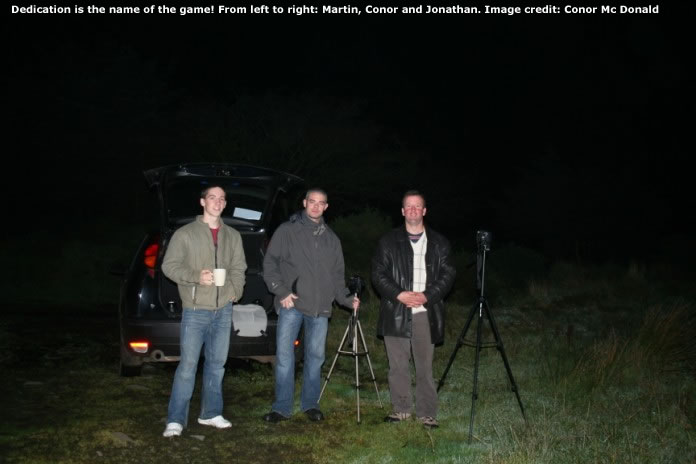 |
Duration of Orionid watch = 5 nights spread over approximately 16 hours of observing.
Total Meteor Count = 118
Total Orionids Observed = 109
Total Non Shower Meteors Observed = 9
Fireballs Observed = 1
Borderline Fireballs Observed = 4
Despite poor weather this year we did get to see some nice action from Halley's comet.
This action is still ongoing at the present time and if I do get a meteor capture I will add it to this report asap. So what's next? we have the Taurids coming very soon and the Leonids in November with enhanced activity predicted and of course my all time favourite Geminid meteor shower in December. Both showers take place during the dark moonless period so watch this space for more reports. Good luck with your own meteor watch. I wish you plenty of fireballs.
Martin McKenna